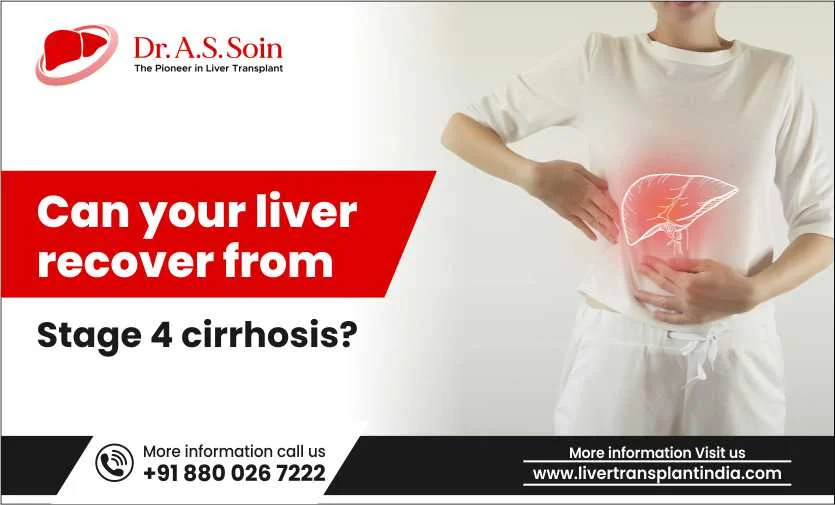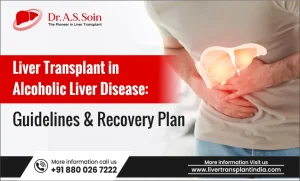Your liver is one of the most vital organs in your body. It processes everything you eat and drink, removes toxins, helps digest food, stores energy, and even plays a role in fighting infections. But what happens when your liver is severely damaged? If you or a loved one has been diagnosed with stage 4 cirrhosis, the most advanced stage of liver disease, you may be wondering: Can the liver recover from this? Is there any hope? This article will explore the reality of stage 4 cirrhosis of liver, treatment options, and what you can do to improve your quality of life.
Table of Contents
ToggleUnderstanding Cirrhosis: The Basics
Cirrhosis is the end result of chronic liver injury. It occurs when healthy liver tissue is gradually replaced by scar tissue—a process called fibrosis. This scarring disrupts the normal structure and function of the liver.
The Process of Scarring
When liver cells are repeatedly injured—the body tries to repair the damage. Initially, this process is beneficial, as the liver regenerates lost tissue. However, when the injury is ongoing, the regeneration process goes awry:
- Fibrosis: With continuous damage, excess collagen and other proteins build up in the liver, forming scar tissue.
- Structural Disruption: Scar tissue replaces the healthy tissue, distorting the liver’s architecture and impairing blood flow.
- Functional Decline: As more healthy tissue is lost, the liver’s ability to perform its vital functions diminishes.
What Causes Cirrhosis?
Several factors can lead to the development of cirrhosis of liver:
Chronic Alcohol Consumption
Excessive and prolonged alcohol use is one of the most common causes. Alcohol metabolism in the liver produces harmful byproducts that lead to inflammation and scar tissue formation.
Chronic Hepatitis Infections
Hepatitis B and C are viral infections that, if not treated, can cause ongoing inflammation and liver damage.
Non-Alcoholic Fatty Liver Disease (NAFLD)
Often related to obesity, diabetes, and metabolic syndrome, NAFLD can progress to a more serious form known as non-alcoholic steatohepatitis (NASH), which can eventually lead to cirrhosis.
Autoimmune Hepatitis and Genetic Conditions
Sometimes the body’s immune system mistakenly attacks liver cells, and conditions like hemochromatosis (excess iron accumulation) or Wilson’s disease (copper accumulation) also contribute to liver damage.
The Stages of Cirrhosis
Cirrhosis of liver progresses through four stages:
- Stage 1 (Compensated Cirrhosis): Minimal scarring; the liver can still perform its essential functions.
- Stage 2 (Significant Scarring): More noticeable damage, leading to complications like portal hypertension (high blood pressure in the liver).
- Stage 3 (Decompensated Cirrhosis): Severe scarring; complications such as ascites (fluid buildup in the abdomen) and hepatic encephalopathy (confusion due to toxin buildup) arise.
- Stage 4 (End-Stage Cirrhosis): This is the final stage, where liver failure occurs, and the only definitive treatment is a liver transplant.
The Liver’s Incredible Regenerative Capacity
The liver is unique in its ability to regenerate. In healthy circumstances, if a portion of the liver is removed or damaged, the remaining liver cells (hepatocytes) can multiply and restore the liver’s size and function. This is why living-donor liver transplants can be successful—the donor’s liver can regenerate even after a section is removed.
However, when cirrhosis of liver reaches stage 4, the regenerative process is severely impaired. The liver cells are trapped within a maze of fibrotic tissue. Despite this, some cirrhosis treatments in India aim to reduce further damage and promote whatever regeneration is possible.
Is Recovery from Stage 4 Cirrhosis Possible?
When discussing recovery, it is important to distinguish between the “reversal” of cirrhosis and the “management” of its progression. True reversal of stage 4 cirrhosis is extremely challenging because the extensive scar tissue fundamentally alters liver structure. However, the term “recovery” can refer to:
- Stabilization of Liver Function: Halting the progression of the disease so that further scarring does not occur.
- Improvement in Quality of Life: Managing complications and symptoms so that patients can lead fuller, healthier lives.
- Slowing Down the Progression: Through various treatments and lifestyle changes, it is possible to slow down or even temporarily stabilize liver damage.
Treatment Options for Stage 4 Cirrhosis
Even though complete regeneration of a severely scarred liver is not possible, there are several strategies to manage stage 4 cirrhosis:
Addressing the Root Cause
Stopping the underlying cause of cirrhosis of liver is crucial. Depending on the condition, the following steps are necessary:
- Alcohol-related cirrhosis: For individuals with alcohol-related liver disease, ceasing alcohol consumption is absolutely critical. Continued alcohol intake can accelerate liver damage exponentially.
- Hepatitis-related cirrhosis: Antiviral medications can significantly lower viral loads, reduce inflammation, and slow down liver damage.
- Fatty liver disease: Weight loss, diabetes control, and dietary changes can reduce fat deposits in the liver and alleviate inflammation.
Lifestyle Changes
A healthy lifestyle can prevent further complications and support the remaining liver function:
- Follow a Low-Sodium Diet – Reducing salt intake helps manage fluid retention and ascites.
- High-Protein Foods: Adequate protein supports liver repair; however, protein intake may need to be moderated in cases of hepatic encephalopathy.
- Eat a Nutritious Diet – Fruits, vegetables, and whole grains help maintain energy and overall health.
- Small, Frequent Meals: This approach can help maintain energy levels and reduce metabolic stress on the liver.
- Stay Hydrated – Drinking enough water helps flush out toxins.
- Exercise Gently – Even moderate exercise improves circulation and overall metabolic health, easing the liver’s workload.
Medications and Medical Management
Although there is no cure for Stage 4 cirrhosis, certain medications can help manage symptoms:
- Diuretics (Water Pills): Diuretics help remove excess fluid from the body, alleviating symptoms like swelling and ascites.
- Beta-Blockers: Beta-blockers are used to lower portal hypertension, reducing the risk of internal bleeding from enlarged veins in the esophagus and stomach.
- Lactulose and Rifaximin: Used for hepatic encephalopathy to prevent toxin buildup in the brain:
- Lactulose: This non-absorbable sugar lowers blood ammonia levels by trapping it in the colon for excretion.
- Rifaximin: An antibiotic that reduces the production of ammonia-producing bacteria in the gut.
- Immunosuppressants: In autoimmune conditions, drugs such as corticosteroids help reduce immune-mediated liver injury.
- Vitamin Supplements: Address deficiencies (e.g., vitamin D, B-complex, or iron).
Managing Complications
Managing complications in Stage 4 cirrhosis is critical to improving survival and quality of life.
- Ascites and Edema: If fluid buildup is severe, doctors may perform paracentesis (removing fluid via a needle).
- Variceal Bleeding: Enlarged veins in the esophagus can rupture and cause life-threatening bleeding; endoscopy procedures can help.
- Hepatic Encephalopathy: Confusion and memory problems due to toxin buildup can be controlled with medications.
Liver Transplant – The Only Cure for Stage 4 Cirrhosis
When all other measures fail and liver function deteriorates severely, a liver transplant becomes the most viable option. Transplantation can provide a new, healthy liver that can perform all necessary functions.
The Role of Liver Transplantation
For many patients with stage 4 cirrhosis, a liver transplant offers hope. Although it is a major surgical procedure with its own risks and challenges, a transplant can be life-saving.
Eligibility for a Liver Transplant?
You may qualify for a liver transplant if:
- You have end-stage liver disease (Stage 4 Cirrhosis).
- Your liver function is severely impaired.
- You are otherwise in good health to undergo surgery.
- You are alcohol-free (if cirrhosis is due to alcohol).
The Transplant Process
The transplant process involves multiple steps:
- Evaluation: A comprehensive assessment by a team of specialists determines if the patient is a good candidate.
- Waiting List: Once approved, patients are placed on a national waiting list. The urgency of their condition and the availability of a matching donor determine the wait time.
- Surgery: The surgical procedure replaces the diseased liver with a healthy donor liver. Post-surgery, patients need to take immunosuppressive drugs to prevent organ rejection.
- Recovery: Recovery from a liver transplant is a long process that involves regular follow-ups and lifestyle adjustments.
What Is the Survival Rate for Stage 4 Cirrhosis?
Without a liver transplant, the life expectancy for stage 4 cirrhosis can be as low as 6 months to 2 years, depending on complications. However, with proper management, some patients can live longer.
With a successful liver transplant:
- 1-Year Survival Rate: 85%-90%
- 5-Year Survival Rate: 70%-75%
Emerging Therapies and Future Directions
While current cirrhosis treatments in India focus on managing symptoms and complications, ongoing research aims to push the boundaries of what is possible for patients with advanced liver disease.
Novel Medications
Scientists are actively investigating drugs that target the mechanisms of fibrosis. These medications work by:
- Reducing Inflammation: Limiting the immune system’s overreaction can help slow scarring.
- Inhibiting Fibrosis: Experimental drugs aim to halt or even partially reverse the deposition of scar tissue.
Recent studies on compounds such as efruxifermin have shown promise in reversing some aspects of liver scarring in patients with metabolic dysfunction-associated steatohepatitis (MASH). Although these treatments are still in clinical trials, they offer hope for the future.
Extracorporeal Liver Support Systems
Devices like the Molecular Adsorbent Recirculating System (MARS) provide temporary support for liver detoxification. These systems help:
- Remove Toxins: By filtering out harmful substances from the blood, they can stabilize patients.
- Bridge to Transplant: They offer a critical window of time for patients awaiting a liver transplant.
While these devices are not a long-term solution, they are invaluable in acute settings and may improve survival rates.
Stem Cell Research and Regenerative Medicine
One of the most exciting areas of research is the potential for stem cell therapy:
- Cell-Based Therapies: Scientists are exploring ways to use stem cells to generate new, healthy liver tissue.
- Bioartificial Liver Devices: These experimental systems combine living liver cells with mechanical support to mimic liver functions.
Although still in the early stages, these innovative approaches may one day revolutionize the treatment of liver cirrhosis.
Final Thoughts
If you or a loved one has been diagnosed with stage 4 cirrhosis of liver, immediate medical intervention is crucial. While the liver cannot heal itself at this stage, cirrhosis treatments in India can extend life, reduce symptoms, and improve quality of life.
For those who need a liver transplant, getting the right doctor is the key to success. Dr. A.S. Soin,https://adspc.ad.gov.ng/ a leading liver transplant surgeon, has helped thousands of patients regain their lives through successful liver transplants. If you or a loved one needs expert guidance, schedule a consultation with Dr. A.S. Soin today.
Your health is in your hands—take action today for a better tomorrow.








